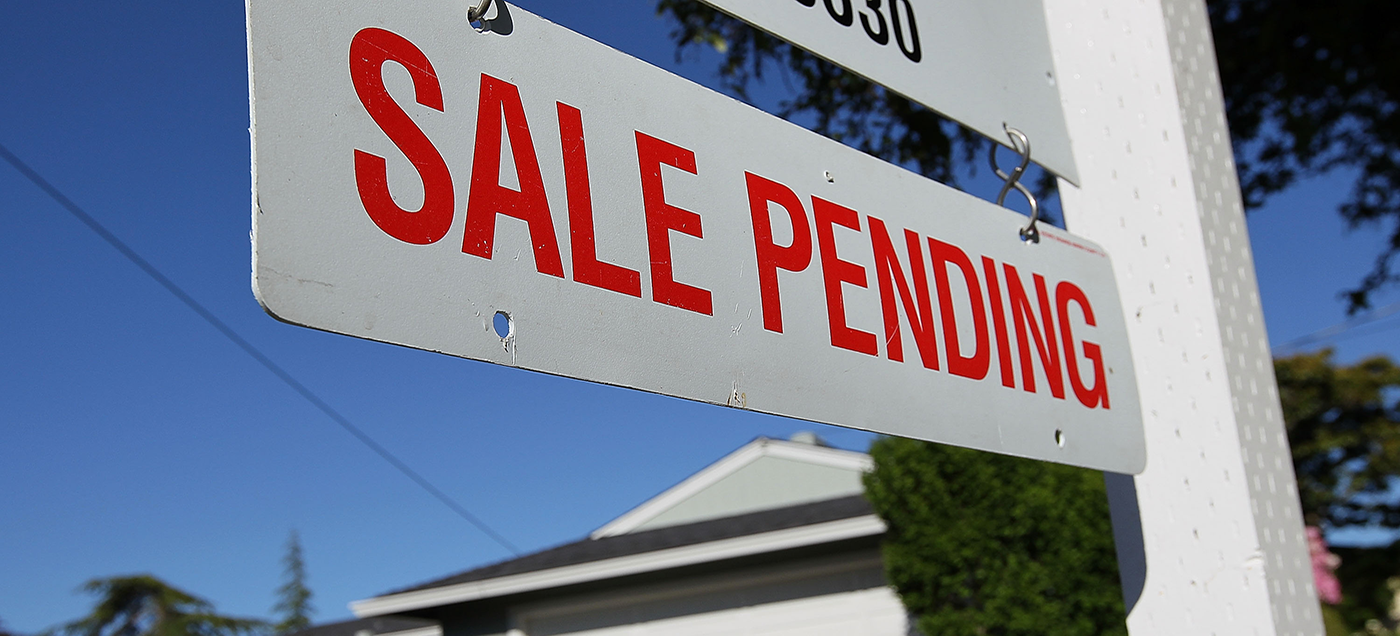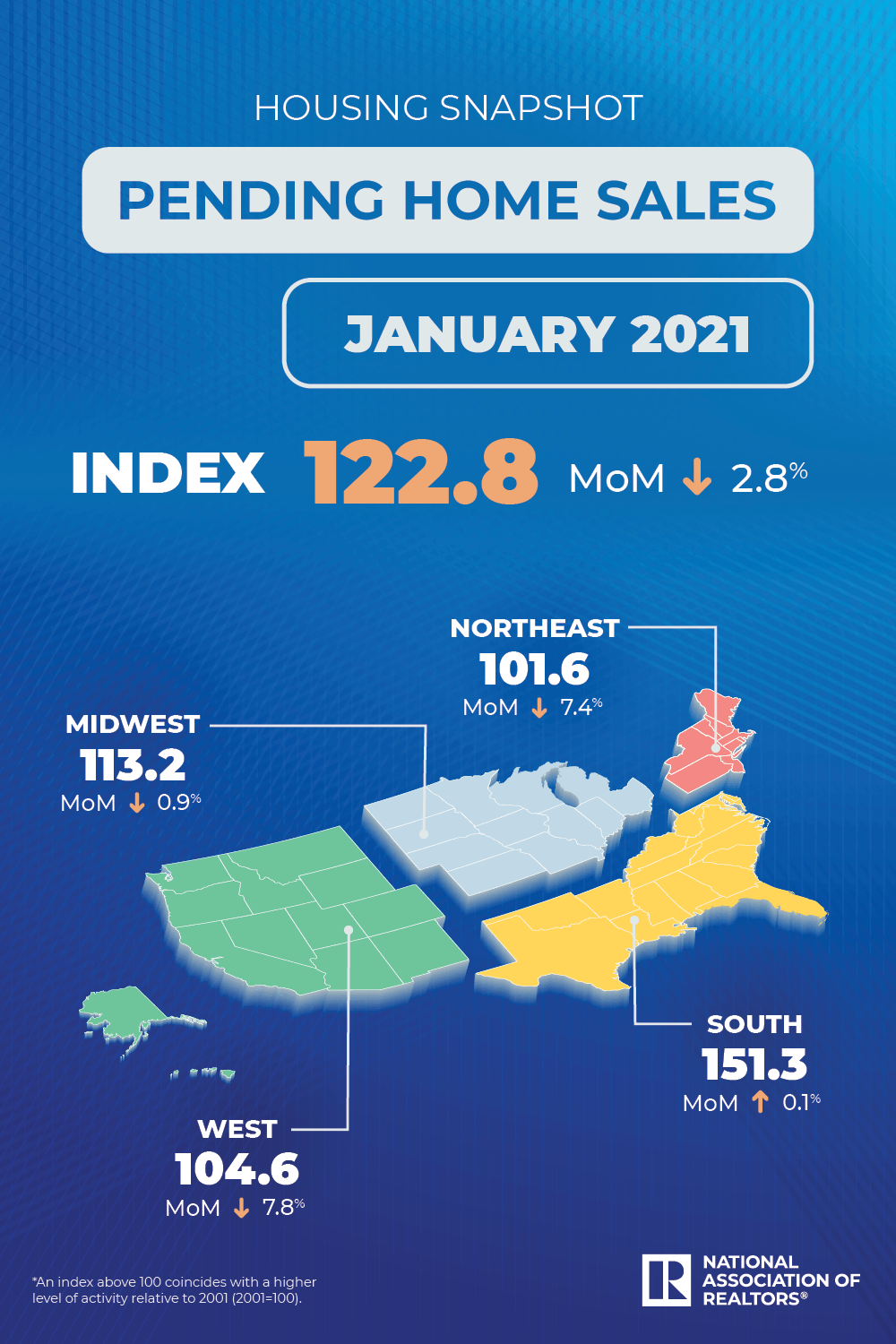Residential Real Estate News

Pending Home Sales in U.S. Slip 3 Percent in January
Residential News » Washington D.C. Edition | By Michael Gerrity | February 26, 2021 8:12 AM ET
According to the National Association of Realtors, pending home sales in the U.S. took a step backward in January 2021 as inventory constraints continue to hold back prospective buyers.
The South was the lone region with a modest gain from the month prior, while the other three major U.S. regions experienced month-over-month decreases in January. However, all four areas saw contract transactions increase from a year-over-year standpoint, including two regions reaching double-digit gains, spurring an all-time high for pending home sales in the month of January.
The Pending Home Sales Index, a forward-looking indicator of home sales based on contract signings, dropped 2.8% to 122.8 in January 2021. Year-over-year, contract signings rose 13.0%. An index of 100 is equal to the level of contract activity in 2001.

"Pending home sales fell in January because there are simply not enough homes to match the demand on the market," said Lawrence Yun, NAR's chief economist. "That said, there has been an increase in permits and requests to build new homes."
There has been a consistent rise in housing permits for single-family homes for eight straight months. According to Yun, this is a good sign that the supply and demand imbalance in the residential real estate market could be easing, as soon as mid-2021.
"There will also be a natural seasonal upswing in inventory in spring and summer after few new listings during the winter months," he said. "These trends, along with an anticipated ramp-up in home construction will provide for much-needed supply."
Realtor.com's Housing Market Recovery Index, which reveals metro areas where the market has recovered or even exceeded prior trends, showed Austin, Texas; Denver, Colo.; San Antonio, Texas; Riverside, Calif.; and Sacramento, Calif., had enjoyed the most significant recovery as of February 13.
Following a week where January's existing-home sales increased, Yun noted that pending contracts are a great early indicator for upcoming closed sales, but stressed that the timing of the relationship between existing-home sales and pending home sales may not be in lockstep.
"The two measurements aren't always perfectly correlated due to varying amounts of time required to close a contract," Yun said. "This is because a number of fallouts can occur due to a variety of factors, including a buyer not obtaining mortgage financing, a problem with a home inspection, or an appraisal issue."
The economy is showing promising signs of improvement, according to Yun, especially in light of many millions of Americans already receiving a COVID-19 vaccination. Still, he cautioned that longer-term interest rates will soon rise, partly from the better economic prospects, but also due to rising inflationary expectations and higher budget deficits.
"I don't foresee mortgage rates jumping to an alarming level, but we should prepare for a rise of at least a decimal point or two," he said.
The Mortgage Bankers Association's AVP of Economic and Industry Forecasting Joel Kan also commented, "Despite a slowdown in January, pending home sales remained 13 percent higher than a year ago, which points to continuing strength in the housing market. The monthly ebbs and flows are a result of the low availability of homes for sale.
"The housing market is very competitive right now, with buyers seeing limited options and faster home-price growth. Various other data sources have pointed to higher median sales prices and record-high purchase mortgage loan sizes, all of which have started to create affordability challenges in many parts of the country. While home building has picked up to attempt to meet the high demand, increased listings of existing homes will be needed in the coming months to alleviate this shortage of housing inventory."
January 2021 Pending Home Sales Regional Breakdown
- The Northeast PHSI fell 7.4% to 101.6 in January, a 9.6% rise from a year ago. In the Midwest, the index declined 0.9% to 113.2 last month, up 8.6% from January 2020.
- Pending home sales transactions in the South inched up 0.1% to an index of 151.3 in January, up 17.1% from January 2020. The index in the West dropped 7.8% in January, to 104.6, up 11.5% from a year prior.
Sign Up Free | The WPJ Weekly Newsletter
Relevant real estate news.
Actionable market intelligence.
Right to your inbox every week.
Real Estate Listings Showcase
Related News Stories
Residential Real Estate Headlines
- U.S. New-Home Sales Surge in August as Mortgage Rates Ease
- Despite Increased Foreign Buyer Activity, Miami Residential Sales Dip 11 Percent in August
- California Home Sales Enjoy Modest Uptick as Mortgage Rates Ease
- U.S. Home-Flipping Profits Sink to Lowest Level Since 2008 Financial Crisis as Costs Climb
- Why the World's Rich Are Flocking to Europe in 2025
- Federal Reserve Delivers First Rate Cut of 2025 as Mortgage Relief Proves Limited
- Homebuilder Sentiment Holds Steady in U.S. as Rate-Cut Bets Lift Outlook
- U.S. Mortgage Rates Experience Sharpest Weekly Drop in Over a Year
- U.S. Foreclosures Rise for Sixth Straight Month as Affordability Pressures Mount
- Black U.S. Homeownership Rate Falls to Two-Year Low as Job Losses Mount
- Las Vegas Home Prices Flatten as Listings Surge, Sales Slow
- Cooling Miami Housing Market Sees 16 Percent Annual Sales Drop in July
- U.S. Mortgage Delinquencies Uptick in June Amid Regional Pressures
- California, Florida Top U.S. Housing Markets Most at Risk of Downturn
- 30-Year Mortgage Drops to 6.56 Percent in Late August, Lowest Since October 2024
- Investors Maintain Elevated Role in U.S. Housing Market Despite Slight Pullback
- Pending Home Sales Show Mixed Signals as U.S. Buyers Remain Cautious
- Canadian Home Sales Extend Recovery in July
- U.S. Home Sales Rise in July as Buyers Gain More Bargaining Power
- Zombie Foreclosures Edge Up Across U.S.
- 2.6 Million Homes at Wildfire Risk Across 14 Western States in 2025
- One in Five Americans Willing to Trade Personal Safety for Home Affordability
- U.S. Home Price Growth Slows as Affordability Pressures Mount in 2025
- U.S. Mortgage Rates Dip to Four Month Low in Early August
- U.S. Mortgage Applications Rise in Late July, Breaking Four-Week Slump
- Hong Kong's Housing Market Stuck in Stalemate as Bulls and Bears Face Off
- U.S. Condo Market Struggles in 2025
- U.S. Pending Home Sales Remain Sluggish in June
- Los Angeles Area Wildfires Destroyed Nearly $52 Billion in Homes Last January
- Greater Palm Beach Area Residential Sales Slip in June Amid Growing Inventory
- Economic Resilience Lifts U.S. Housing Outlook Going Forward
- New Home Sales Stagnate as Affordability Struggles Continue in America
- U.S. Housing Market Slips in June as Prices Hit New Highs
- Florida, California Continue to Reign Supreme as America's Ultraluxury Housing Markets
- Caribbean Housing Market Evolves into Global Second-Home Hotspot
- U.S. Home Sales See Highest June Cancellation Rate on Record
- Orlando Housing Market Cools in June as Listings Slide, Sales Slow
- Private Credit Surges in 2025 as Real Estate Developers Bypass Banks
- U.S. Condo Market Suffers Sharpest Price Drops in Over a Decade as Buyers Retreat
- Rising Taxes, Insurance Costs Undermine the Stability of U.S. Homeownership








